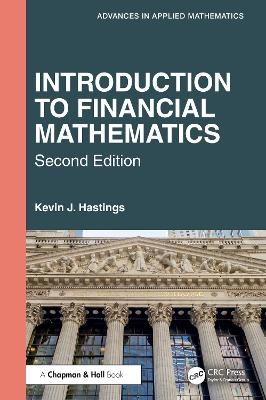
Introduction to Financial Mathematics
Chapman & Hall/CRC (Verlag)
978-1-032-26236-9 (ISBN)
Therefore, there is substantial material in Introduction to Financial Mathematics, Second Edition on the theory of interest (the first half of the book), as well as the probabilistic background necessary for the study of portfolio optimization and derivative valuation (the second half). A course in multivariable calculus is not required.
The material in the first two chapters should go a long way toward helping students prepare for the Financial Mathematics (FM) actuarial exam. Also, the discrete material will reveal how beneficial it is for the students to know more about loans in their personal financial lives.
The notable changes and updates to this edition are itemized in the Preface, but overall, the presentation has been made more efficient. One example is the chapter on discrete probability, which is rather unique in its emphasis on giving the deterministic problems studied earlier a probabilistic context. The section on Markov chains, which is not essential to the development, has been scaled down. Sample spaces and probability measures, random variables and distributions, expectation, conditional probability, independence, and estimation all follow.
Optimal portfolio selection coverage is reorganized and the section on the practicalities of stock transactions has been revised. Market portfolio and Capital Market Theory coverage is expanded. New sections on Swaps and Value-at-Risk have been added.
This book, like the first edition, was written so that the print edition could stand alone. At times we simplify complicated algebraic expressions, or solve systems of linear equations, or numerically solve non-linear equations. Also, some attention is given to the use of computer simulation to approximate solutions to problems.
Kevin J. Hastings is emeritus professor of mathematics; Rothwell C. Stephens Distinguished Service Chair at Knox College. He holds a PhD from Northwestern University. His interests include applications to real-world problems affected by random inputs or disturbances. He is the author of Chapman & Hall/CRC books: Financial Mathematics: From Discrete to Continuous Time, 2022; Introduction to Probability with Mathematica®, 2nd ed., 2019; and Introduction to the Mathematics of Operations Research with Mathematica®, 2nd ed., 2019.
Contents
Preface xi
1 Theory of Interest
1.1 Rate of Return and Present Value
1.2 Compound Interest
1.2.1 Geometric Sequences and Series
1.2.2 Compound Interest
1.2.3 Discounting
1.2.4 Present Value and Net Present Value
1.3 Annuities
1.3.1 Ordinary Annuities
1.3.2 Annuities Due
1.3.3 Variations on Annuities
1.4 Loans
1.4.1 Loan Payments
1.4.2 Loan Amortization
1.4.3 Retrospective and Prospective Forms for Outstanding
Balance
1.4.4 Sinking Fund Loan Repayment
1.5 Measuring Rate of Return
1.5.1 Internal Rate of Return on a Transaction
1.5.2 Approximate Dollar-Weighted Rate of Return
1.5.3 Time-Weighted Rate of Return
1.6 Continuous Time Interest Theory
1.6.1 Continuous Compounding: Effective Rate and Present
Value
1.6.2 Force of Interest
1.6.3 Continuous Annuities
1.6.4 Continuous Loans3
2 Bonds
2.1 Bond Valuation
2.1.1 Bond Value at Issue Date
2.1.2 Bond Value at Coupon Date
2.1.3 Recursive Approach: Bond Amortization Table
2.2 More on Bonds
2.2.1 Value of a Bond between Coupons
2.2.2 Callable and Putable Bonds
2.2.3 Bond Duration
2.3 Term Structure of Interest Rates
2.3.1 Spot Rates, STRIPS, and Yield to Maturity
2.3.2 Forward Rates and Spot Rates
3 Discrete Probability for Finance
3.1 Sample Spaces and Probability Measures
3.1.1 Counting Rules
3.1.2 Probability Models
3.1.3 More Properties of Probability
3.2 Random Variables and Distributions
3.2.1 Cumulative Distribution Functions
3.2.2 Random Vectors and Joint Distributions
3.3 Discrete Expectation
3.3.1 Mean
3.3.2 Variance
3.3.3 Chebyshev’s Inequality
3.3.4 Expectation for Multiple Random Variables
3.4 Conditional Probability
3.4.1 Fundamental Ideas
3.4.2 Conditional Distributions of Random Variables
3.4.3 Conditional Expectation
3.5 Independence and Dependence
3.5.1 Independent Events
3.5.2 Independent Random Variables
3.5.3 Dependence: Covariance and Correlation
3.6 Estimation
3.6.1 The Sample Mean
3.6.2 Sample Variance, Covariance, and Correlation
4 Portfolio Theory
4.1 Portfolios of Risky Assets
4.1.1 Some Practical Background
4.1.2 Stock Transactions
4.1.3 Asset Rates of Return: Modeling and Estimation
4.1.4 Portfolio Rate of Return
4.1.5 Risk Aversion
4.2 Optimal Portfolio Selection
4.2.1 Two-Asset Problems
4.3 Multiple-Assets and Portfolio Separation
4.3.1 Market Portfolio
5 Valuation of Derivatives
5.1 Basic Terminology and Ideas
5.1.1 Derivative Assets
5.1.2 Arbitrage
5.1.3 Arbitrage Valuation of Futures
5.2 Single-Period Options
5.2.1 Pricing Strategies
5.2.2 Put-Call Parity
5.2.3 Δ-Hedging
5.3 Multiple-Period Options
5.3.1 Martingale Valuation
5.3.2 Valuation by Chaining
6 Additional Topics 335
6.1 Valuation of Exotic Options and Simulation
6.1.1 American Options
6.1.2 Barrier Options
6.1.3 Asian Options
6.1.4 Approximate Valuation by Simulation
6.2 Swaps
6.2.1 Interest Rate Swaps
6.2.2 Commodity Swaps
6.2.3 Currency Swaps
6.3 Value-at-Risk
6.3.1 Computing VaR for Individual Assets and Portfolios
6.3.2 Conditional Value-at-Risk
6.3.3 Simulation Approximations
Appendix A Short Answers to Selected Exercises
Bibliography
Index
| Erscheinungsdatum | 23.10.2024 |
|---|---|
| Reihe/Serie | Advances in Applied Mathematics |
| Zusatzinfo | 73 Line drawings, black and white; 73 Illustrations, black and white |
| Sprache | englisch |
| Maße | 156 x 234 mm |
| Gewicht | 930 g |
| Themenwelt | Mathematik / Informatik ► Mathematik ► Angewandte Mathematik |
| Wirtschaft ► Betriebswirtschaft / Management ► Finanzierung | |
| ISBN-10 | 1-032-26236-2 / 1032262362 |
| ISBN-13 | 978-1-032-26236-9 / 9781032262369 |
| Zustand | Neuware |
| Informationen gemäß Produktsicherheitsverordnung (GPSR) | |
| Haben Sie eine Frage zum Produkt? |
aus dem Bereich


